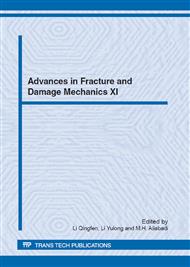p.401
p.405
p.409
p.413
p.417
p.421
p.425
p.429
p.433
Effects of Surface Roughness on the Fatigue Life of Alloy Steel
Abstract:
Surface roughness characterizes the micro-geometric appearance variation and significantly affects the fatigue properties of machined specimen. Low cycle fatigue (LCF) tests of alloy steel specimens with different surface roughness were carried out in this paper to investigate the effect of roughness on fatigue life. The dumbbell plate specimens were tested in uniaxial stress-controlled mode on the hydraulic servo machine at room temperature. Obviously discrepant lifetime results corresponding to different surface roughness implied that the greater the roughness was, the lower the fatigue life was. An approximate power function relationship between the roughness and the fatigue life was established through the fitting of the experimental data.
Info:
Periodical:
Pages:
417-420
Citation:
Online since:
November 2012
Keywords:
Price:
Сopyright:
© 2013 Trans Tech Publications Ltd. All Rights Reserved
Share:
Citation:


